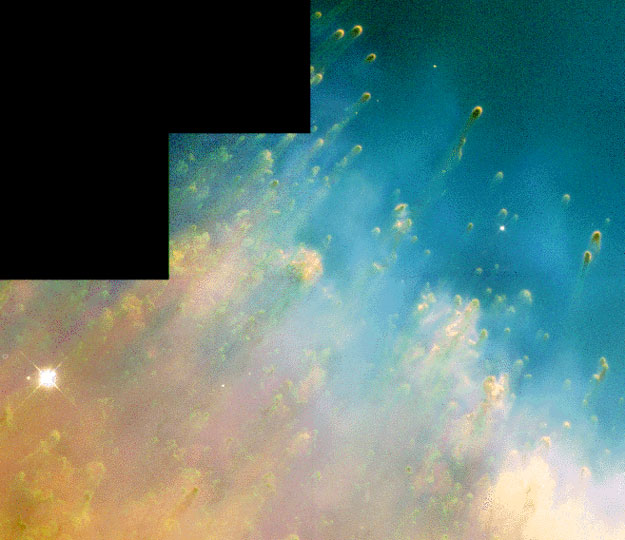Astronomy Picture of the Day
Discover the cosmos! Each day a different image or photograph of our fascinating universe is featured, along with a brief explanation written by a professional astronomer.
Posted on 05/09/2003 10:50:08 PM PDT by petuniasevan
Discover the cosmos! Each day a different image or photograph of our fascinating universe is featured, along with a brief explanation written by a professional astronomer.
Explanation: Will our Sun look like this one day? The Helix Nebula is the closest example of a planetary nebula created at the end of the life of a Sun-like star. The outer gasses of the star expelled into space appear from our vantage point as if we are looking down a helix. The remnant central stellar core, destined to become a white dwarf star, glows in light so energetic it causes the previously expelled gas to fluoresce. The Helix Nebula, given a technical designation of NGC 7293, lies about 650 light-years away towards the constellation of Aquarius and spans about 2.5 light-years. The above picture is a composite of newly released images from the ACS instrument on the Hubble Space Telescope and wide-angle images from the Mosaic Camera on the 0.9-m Telescope at Kitt Peak National Observatory. A close-up of the inner edge of the Helix Nebula shows complex gas knots of unknown origin.
I will be on vacation from June 2nd through June 9th.
If anyone would like to volunteer to post APOD during that time, please FReepmail me.
Otherwise the APOD will not be posted as I will be visiting relatives in California.
On last night's thread, a FReeper posted a link to his brother's astrophotography website. It's good! Check out the site - these guys are serious photogs!
Close-up of a portion of the Helix Nebula (courtesy of Hubble)

The Helix Nebula, NGC 7293
| Right Ascension | 22 : 29.6 (h:m) |
|---|---|
| Declination | -20 : 48 (deg:m) |
| Distance | 0.45 (kly) |
| Visual Brightness | 7.3 (mag) |
| Apparent Dimension | 16 / 28 (arc min) |

This is one of those odd objects which is actually easier to find through a good pair of binoculars than through a telescope! Dark skies are required! An O-III filter is highly recommended! You may see something like this in an 8-inch 'scope:


Most nebula images are taken through filters to bring out the colors and details desired. The Hubble contribution to the above image is like thus:
Helix was exposed in two filters, Ha+[N II] (F658N) and [O III] (F502N). The WFPC2 images, obtained in parallel, covered portions of the nebula in [O I] (F631N), He II (F469N), or Ha (F656N).
Those are different filters which allow light through at only a narrow band (such as the ionized oxygen line at 502 nanometers).
If you looked through a good-sized 'scope at low power, with perfect seeing, you might actually see the Helix as faintly blue-green! This doesn't mean the camera lies; it has different and greater sensitivity than does the human eye. Also remember that all such images are time exposures of several minutes to several hours.
Try looking at this web page to see what went into the composite image that graces today's APOD.
Amateur color images show the nebula as red:

As does a large observatory's instruments:

By the way, thanks for asking, and thanks for visiting APOD!
Disclaimer: Opinions posted on Free Republic are those of the individual posters and do not necessarily represent the opinion of Free Republic or its management. All materials posted herein are protected by copyright law and the exemption for fair use of copyrighted works.